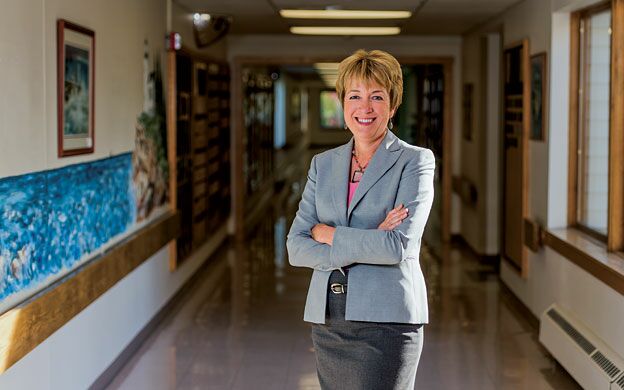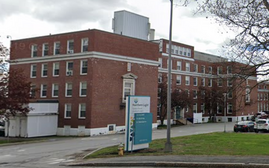Processing Your Payment
Please do not leave this page until complete. This can take a few moments.
- News
-
Editions
View Digital Editions
Biweekly Issues
- December 1, 2025
- Nov. 17, 2025
- November 03, 2025
- October 20, 2025
- October 6, 2025
- September 22, 2025
- + More
Special Editions
- Lists
- Viewpoints
-
Our Events
Event Info
Award Honorees
- Calendar
- Biz Marketplace
Sylvia Getman leads The Aroostook Medical Center down a more sustainable path
 PHOTo / Sha-Lam Photography
PHOTo / Sha-Lam Photography
Sylvia Getman, president and CEO of The Aroostook Medical Center in Presque Isle, says the transformations taking place in health care right now are akin “to building an airplane while you're flying it.” Letting the impossible nature of that challenge sink in for a moment, she completes the thought: “If I'm in that airplane I'd want to work with other people who'd built airplanes before. I'd like to know they'd built an airplane that could fly. And I'd want to know we had the right parts to complete the job.”
In the three years since she assumed the reins of Aroostook County's largest employer — TAMC employs 1,000 people at seven facilities within The County — Getman has embraced the leadership challenges of guiding a rural health care system during a time of rapid change. There's the Affordable Care Act and its push for health care reforms in which payments will be based on quality, not quantity. The shift to electronic medical record recordkeeping. Public demand for transparency regarding the costs and quality of health care. Payment reforms in Medicare and Medicaid. The list goes on, and every item on it generally is linked to another problem needing to be fixed.
Underlying all of those changes is the realization that health care, as it's been delivered for the past 20 or 30 years, is unsustainable.
“The math doesn't work going forward,” Getman says. “Those who work in the health care system see that more clearly than anyone else. The simple reality in health care is that the system can't go on the way it has been going. Things have to change. You can't cut your way out of it, you can't grow your way out of it. So you need to do something that's different.”
Getman brings an unabashedly positive outlook to the urgent challenge of fixing health care in Maine's uppermost county. She admits her glass is always half full.
“When you say 'challenges,' I say 'opportunities' — every time,” she says.
VIDEO: How Getman would invest a $10 million grant to TAMC.
Prior to coming to TAMC in August 2010, Getman's medical career had given her opportunities to see what works in hospital settings both large and small. Her large-hospital stint at the University of Kansas Medical Center included working as an assistant director of medical affairs. In a shift, she followed that with a move toward executive-level hospital assignments at smaller rural hospitals in Iowa and, more recently, in Massachusetts.
“I absolutely fell in love with rural health care,” she says, noting that one of her roles in Iowa involved an electronic health record project linking a major medical center with eight rural hospitals. In the smaller hospital settings, she came to appreciate the decision-making nimbleness that's possible in contrast to a large hospital setting “where you meet for nine months and then you have a plan.”
Another learning experience involved bringing the “continuous process improvement” approaches more commonly found in manufacturing to a hospital setting. Quality improvements can happen by accident, she acknowledges, but not reliably. If quality patient care is to become the norm, she says, there needs to be an unwavering commitment from top to bottom setting that as the goal.
An opportunity for change
Getman says the CEO opening at TAMC in 2010 appealed to her precisely because she saw the challenges it faced — being a “high-cost” hospital system in Maine's most rural county — as an opportunity to be a leader in the health care reform initiatives that were gaining momentum both locally and nationally.
“I didn't go there by accident,” she says of the move to TAMC with her husband and their three sons. “I saw that there was a really strong team in place, with a lot of pieces to work with. I saw an organization with high quality of care, but the public perception didn't see it that way.”
Three immediate challenges loomed from the start:
- Decreasing reimbursements from the federal government for Medicare and Medicaid
- Getting a sight line on the Affordable Care Act and its 2,000 pages of reforms impacting the delivery and cost of health care
- Dealing with budget uncertainties stemming from the lingering $484 million MaineCare debt, with TAMC's share pegged by the LePage administration at $12.4 million earlier this year.
The MaineCare debt, Getman says, complicated virtually every financial decision she's had to face in her first three years, largely because until an agreement was reached this year between the Legislature and Gov. Paul LePage on how to pay off that debt, there was always the question “Would we ever get paid?”
She says to her relief, TAMC received its check from the state canceling the longstanding debt in mid-September.
Not surprisingly, Getman tackled the other challenges by pursuing operational approaches she had learned could be as effective in hospital settings as they had been for Toyota and other manufacturers.
To naysayers who initially worried about posting TAMC's quality measurements on its website — including target goals and outcomes for quality indicators such as “infection prevention,” “surgical care,” “patient safety” and “satisfaction” — Getman replied that public accountability was an essential step toward improving perceptions about the hospital. She says the implementation of electronic medical records, likewise, supports the lean goals of providing the right information about patients to doctors and nurses, at the right time and in the right format.
“What are the things that aren't working?” Getman says is a question she frequently asks. It's followed by questions she hopes will logically lead her TAMC team down the path of solving those problems: “If not us, then who? If not now, then when?”
Getman, who is also a senior vice president at Eastern Maine Healthcare Systems, regards TAMC's affiliation with EMHS's Pioneer Accountable Care Organization as a critical step in her hospital's transformation. As one of the first 32 Pioneer ACOs set up across the United States by the Centers for Medicare and Medicaid Services in December 2011, EMHS's five-year pilot program is shifting from a fee-for-service model of payment to a model that will reward health care providers for keeping their Medicare patients healthy. Instead of passively waiting to treat their patients' illnesses — and having a fee structure in which more visits, tests and procedures equals more revenue — the Pioneer ACO model encourages a proactive approach coordinated among providers, patients and their families.
Getman says EMHS's Pioneer ACO program (now called Beacon Health) recently learned it is the sixth highest performer of the original 32 Pioneer pilot ACOs created almost two years ago.
“I'm from Missouri, the 'Show Me' state,” Getman says. “I can authentically say this is working [to achieve the triple goals of highest quality care and satisfied patients at the lowest cost.]”
It's been a busy three years, and Getman is pleased the efforts she and her TAMC team have been making are being recognized. Locally, the hospital system was named Business of Year by Central Aroostook Chamber of Commerce in 2012. It was one of only four hospitals in Maine designated by the Joint Commission in 2012 as a top performer in key quality measures; it also received an “A” hospital safety score last November from The Leapfrog Group. In May it received two honors from Avatar Solutions, a survey, data measurement, and performance improvement company and in September, TAMC was named one of the top 25 “most wired” rural hospitals in the 15th annual Hospitals & Health Networks survey.
More than awards or outside recognition, Getman says it's the small moments that remind her why she's in health care, like the nurse who declined being relieved after hours of comforting a crying baby. “He's more comfortable with me,” the nurse told Getman.
“If you have good people and if they understand the importance of what they're doing, that for me is a great 'swoosh' moment,” she says. “I see moments like that every day and it reminds me, every day, what we're trying to do here. Every day I clearly know what my purpose is — and that's a gift.”
Read more
Scientists Kevin Strange and Voot Yin probe the mysteries of regenerative tissue
Josh Shea reflects today's L-A with his magazine and film festival
Chris Kilgour's Telford buyout yields surprising rewards
Masey Kaplan builds a better fundraising tool for schools and nonprofits
Allagash International's Terry Ingram breaks into foreign markets
Tom Hall drives his marketing company and Portland’s technology connections
The Fletchers keep western Maine's wood-products industry spinning
Gayle Brazeau shepherds Maine's next generation of pharmacists into service
Scientists Kevin Strange and Voot Yin probe the mysteries of regenerative tissue
Josh Shea reflects today's L-A with his magazine and film festival
Chris Kilgour's Telford buyout yields surprising rewards
Masey Kaplan builds a better fundraising tool for schools and nonprofits
Allagash International's Terry Ingram breaks into foreign markets
Tom Hall drives his marketing company and Portland’s technology connections
The Fletchers keep western Maine's wood-products industry spinning
Gayle Brazeau shepherds Maine's next generation of pharmacists into service
Sylvia Getman
President/CEO The Aroostook Medical Center, Presque Isle
The Aroostook Medical Center
Mainebiz web partners
Related Content

The Giving Guide
The Giving Guide helps nonprofits have the opportunity to showcase and differentiate their organizations so that businesses better understand how they can contribute to a nonprofit’s mission and work.
Learn More
Work for ME
Work for ME is a workforce development tool to help Maine’s employers target Maine’s emerging workforce. Work for ME highlights each industry, its impact on Maine’s economy, the jobs available to entry-level workers, the training and education needed to get a career started.
Learn More
Groundbreaking Maine
Whether you’re a developer, financer, architect, or industry enthusiast, Groundbreaking Maine is crafted to be your go-to source for valuable insights in Maine’s real estate and construction community.
Learn more-
The Giving Guide
The Giving Guide helps nonprofits have the opportunity to showcase and differentiate their organizations so that businesses better understand how they can contribute to a nonprofit’s mission and work.
-
Work for ME
Work for ME is a workforce development tool to help Maine’s employers target Maine’s emerging workforce. Work for ME highlights each industry, its impact on Maine’s economy, the jobs available to entry-level workers, the training and education needed to get a career started.
-
Groundbreaking Maine
Whether you’re a developer, financer, architect, or industry enthusiast, Groundbreaking Maine is crafted to be your go-to source for valuable insights in Maine’s real estate and construction community.
ABOUT
NEW ENGLAND BUSINESS MEDIA SITES
No articles left
Get access now
In order to use this feature, we need some information from you. You can also login or register for a free account.
By clicking submit you are agreeing to our cookie usage and Privacy Policy
Already have an account? Login
Already have an account? Login
Want to create an account? Register
Get access now
In order to use this feature, we need some information from you. You can also login or register for a free account.
By clicking submit you are agreeing to our cookie usage and Privacy Policy
Already have an account? Login
Already have an account? Login
Want to create an account? Register










Comments